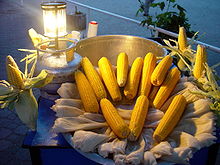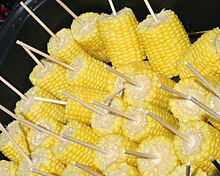Corn on the cob (known regionally as "pole corn", "cornstick", "sweet pole", "butter-pop" or "long maize") is a culinary term used for a cooked ear of freshly picked maize from a cultivar of sweet corn. Sweet corn is the most common variety of maize eaten directly off the cob. The ear is picked while the endosperm is in the "milk stage" so that the kernels are still tender. Ears of corn are steamed or boiled, usually without their green husks, or roasted with them. The husk leaves are in any case removed before serving.
Cooked corn on the cob with serving sticks.
Corn on the cob is normally eaten while still warm. It is boiled or grilled. It is then often seasoned with salt and buttered before serving. Some diners use specialized skewers, thrust into the ends of the cob, to hold the ear while eating without touching the hot and sticky kernels.
Preparation
Cooking corn on the cob by boiling.
The most common methods for cooking corn on the cob are frying, boiling, roasting, and grilling. Corn on the cob can be grilled directly in its husk, or it can be husked first and then wrapped in aluminum foil. When oven roasting, cooking the corn in the husk directly on the rack is recommended. When roasting or grilling corn on the cob, the cook can first peel the husk back to rub the corn with oil or melted butter, then re-secure the husk around the corn with a string.
Freshly picked ears of sweet corn.
Common condiments and seasonings for corn on the cob include butter, salt, and black pepper.
Etiquette
Lillian Eichler Watson, in a 1921 etiquette book, described corn on the cob as "without a doubt one of the most difficult foods to eat gracefully."She added that "it is entirely permissible to use the fingers in eating corn, holding it lightly at each end; sometimes a napkin is used in holding it." Sometimes, however, a short sharp knife would be provided that each diner could use to cut or scrape the kernels from the cob for later eating. She described this as "by far the most satisfactory method" of eating corn on the cob.
Some etiquette books recommend salting and buttering the corn a section at a time just before eating that section, which helps to minimize the mess on the diner's face and hands. Butter dripping down the diner's chin and kernels getting stuck in-between teeth may be a source of embarrassment for the diner.
Skewers
Skewers for eating corn on the cob.
Corn skewers (also called corncob holders) are eating utensils used to hold corn on the cob.
Skewers have been used since ancient times, ranging from articles made of wood found in ethnographic museums to precious tableware made of silver.
HistoryCorn was eaten by Native American tribes before European settlers arrived in the Americas. The Maya ate corn as a staple food crop and ate it off the cob, either roasting or boiling it.
References
- ^ a b Nielsen, L. Michelle (2007). The Biography of Corn. Crabtree Publishing Company. p. 27.
- ^ "How to Grill Corn on the Cob. What's Cooking in America. Retrieved 23 March 2012.
- ^ Florence, Tyler. "Oven Roasted Corn on the Cob". Food Network. Retrieved 29 March2012.
- ^ a b Herbest, David (2003). Simply Perfect Every Time: 130 Classic, Foolproof Recipes. New York: Avalon Publishing Groups Incorporated. p. 58.
- ^ Watson, Lillian Eichler (1921). Book of Etiquette: Volume One. Garden City, New York: Nelson Doubleday Inc. p. 32.
- ^ Sabath, Ann Marie (1993). Business Etiquette in Brief. Canada: Adams Media. p. 106.
- ^ a b Garner, Curtise (2009). The New Rules of Etiquette. Avon, Massachusetts: Adams Media. p. 76.
- ^ Chaney, Lillian H. (2007). The Essential Guide to Business Etiquett. Westport, Connecticut: Praeger Publishers. p. 94.
- ^ "Corncob holder from wood made in Kenya. Horniman Museum and Gardens.
- ^ "Sterling Corn Cob Holder. Ancient Point.
- ^ Nielsen 2007. p 11.
- Wikipedia







No comments:
Post a Comment